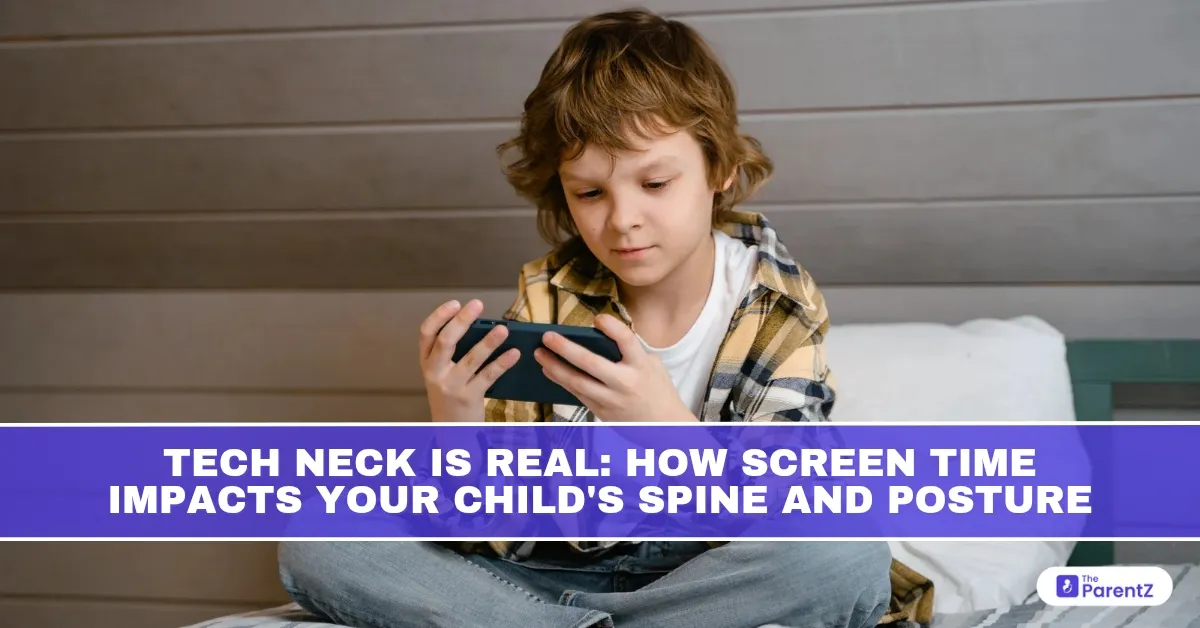This Is Something Every Parent Should Be Aware Of
If your child is like most kids today, they’re spending hours hunched over screens, be it online classes, games, or scrolling on a phone. But what you might not realise is that this innocent habit could be quietly affecting their spine, posture, and even long-term growth. This condition has a name, Tech Neck, and it’s more real and common than ever, especially among children and teenagers. As parents, understanding what it is and how to prevent it is key to protecting your child’s posture and spinal health during their crucial growing years.
What Is “Tech Neck”?
Tech neck refers to neck pain, stiffness, and spinal strain caused by prolonged forward head posture, typically from looking down at screens for extended periods.
When your child tilts their head to look down at a screen, the weight their neck supports increases dramatically. According to a study published in Surgical Technology International, a human head weighs about 10–12 pounds in a neutral position. But at a 60-degree angle (like when looking down at a phone), it can feel like 60 pounds to the cervical spine!
How Screen Time Affects Your Child’s Posture
Over time, poor posture from excessive screen use can lead to:
- Forward head posture (head juts out beyond the shoulders)
- Rounded shoulders
- Muscle imbalances in the neck, shoulders, and upper back
- Spinal misalignment and early wear and tear on cervical discs
In children, whose bones are still developing, these changes can be even more impactful and may lead to chronic pain, poor breathing mechanics, and reduced confidence due to slouched posture.
Warning Signs of Tech Neck in Children
Be on the lookout for:
- Complaints of neck or upper back pain
- Headaches (especially at the base of the skull)
- Slouching or rounded shoulders
- Difficulty sitting upright for long periods
- Tingling or numbness in arms (in more severe cases)
PubMed Evidence: Why This Is Serious
A 2021 review in the Journal of Bodywork and Movement Therapies found that forward head posture in children due to technology use is associated with:
- Decreased respiratory function
- Reduced muscle strength in the neck and back
- Headaches and visual strain
- Lower physical activity levels
Another study in BMC Musculoskeletal Disorders highlighted that children with poor sitting habits are more likely to experience early signs of musculoskeletal dysfunction in adolescence.
What You Can Do: 7 Ways to Protect Your Child’s Spine
You can’t remove screens from their lives—but you can absolutely teach healthy tech habits and spinal care from the start.
1. Encourage Screen Breaks
Follow the 20-20-20 rule:
- Every 20 minutes, look at something 20 feet away for at least 20 seconds.
This reduces eye strain and gives the spine a break.
2. Improve Their Screen Setup
- Keep screens at eye level to avoid tilting the head.
- Encourage sitting against a backrest, with feet flat on the floor.
- Use books or stands to raise tablets/laptops.
- Avoid screen time while lying in bed or on the floor.
3. Strengthen Their Core and Back
A strong core supports the spine. Encourage:
- Planks
- Superman stretches
- Shoulder blade squeezes
- Yoga (especially child’s pose, cat-cow, and cobra)
Make it a fun family activity!
4. Use Posture Reminders
- Stick cute reminders on their devices: “Chin up!” or “Straight spine!”
- Set daily posture-check alarms.
- Show them a mirror image of their posture—self-awareness helps!
5. Limit Recreational Screen Time
The American Academy of Pediatrics recommends:
- Under 2 years: No screen time (except video calls)
- 2–5 years: Max 1 hour per day
- 6+ years: Consistent limits & screen-free zones
Set boundaries and encourage screen-free family time.
6. Get Moving
Motion is lotion for the spine! Ensure daily physical activity:
- Dancing
- Cycling
- Swimming
- Outdoor play
This naturally counters the static load of sitting.
7. Lead by Example
Your posture matters too! Children imitate what they see. So, sit up straight, hold your phone at eye level, and take breaks often.
When to See a Specialist
If your child is experiencing persistent neck pain, stiffness, or noticeable postural changes, consult a pediatric orthopedist or physical therapist. Early intervention can prevent long-term issues.
Conclusion: Small Habits Now, Strong Spines for Life
Tech neck is a modern-day concern, but it’s one we can tackle with awareness, smart habits, and a little creativity. By teaching your child how to sit, move, and rest with their spine in mind, you’re helping them build a foundation of lifelong musculoskeletal health. Screens are here to stay, but so is your power as a parent to protect and nurture your child’s growing body. Let’s raise strong minds and strong spines.








Be the first one to comment on this story.